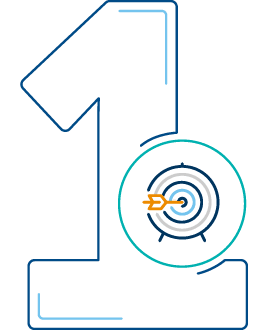Boost Process Improvement Success by Starting with the Right Projects
On every campus, the list of administrative tasks that could benefit from standardization, simplification, automation, or other improvements is a mile long. Instinct says to focus first on processes with the greatest impact on mission and margin. We recommend starting with strategic quick wins that earn buy-in for higher effort—and higher impact—projects. Proving the value of process improvement in the short term lays a foundation for engagement in the long term—so it’s critical to begin with the right projects.

Amplify “customer” voices in collecting improvement ideas
Senior leaders should champion strategic objectives and larger efficiency opportunities across campus. But their vantage point can overlook frustrations among the “customers” of administrative tasks, whether faculty, students, or frontline staff. Amplifying customer voices can illuminate areas of frustration, confusion, or redundancy in administrative services while also engaging them in process improvement projects.

Leverage customer input with these methods
-
Existing campus forums
Many campuses bring together segments of staff distributed across campus, whether administrative generalists or business officers, to share new initiatives. “Flipping” the format can empower staff to crowdsource what works and what doesn’t work in their everyday workflows. For example, at the University of Virginia, the Organizational Excellence team facilitates Quality Core sessions to spark cross-departmental interaction. UVA’s campus-wide use of an electronic signature platform began at one of these sessions, after a unit reported on its use of the tool to streamline business processes.
-
Targeted focus groups
Kick off a process improvement initiative by bringing together administrative staff for a facilitated conversation about their frustrations. Engaging them from the beginning sets an expectation for ongoing involvement. For example, at the University of Louisville, process improvement focus groups have taken two forms. First, deans, school business officers, and directors of central administrative units met to determine a top-10 list of frustrating processes. Then, staff and customers involved in each of those specific processes were convened for a more in-depth conversation about process breakdown.
-
Surveys
Surveys can tap into a wider range of perspectives with a less intrusive expectation of participant time. Surveys are particularly effective in soliciting the opinions of faculty and students about the service levels they receive from administrative departments. For example, at the University of Maryland, Baltimore County, campus leaders captured a wide swath of input by asking business staff and faculty partners to rank their frustrations with administrative work. The results were used to divide process improvement projects into two categories of quick wins and long-term opportunities.
Rank process improvement opportunities based on institutional priorities
Staff, faculty, and student perspectives are critical to determine where to begin process improvement activities. But they are not the only factors to consider. Campuses should weigh process improvement opportunities against a common set of priorities that meaningfully impact the urgency and feasibility of redesign—such as organizational readiness, strategic alignment, and customer impact.

Elevate quick wins to open the door for future opportunities
When determining where to begin the process improvement journey, campus leaders should elevate universally frustrating processes that can be redesigned quickly. Experienced institutions have capitalized on early wins to secure stakeholder buy-in for bigger opportunities that they couldn’t have pursued unilaterally.


Assemble a process-specific team to lead improvements
After identifying the right starting point for redesign via the prioritization exercise, assemble a team of people to run the process improvement playbook. For early projects, senior leaders should be involved in recruiting team members, conveying the importance of the initiative, and clearing any roadblocks to completion.

Empower a process improvement coordinator to oversee redesign efforts
Process improvement teams need someone who can take the lead on managing logistics, communicating with the project sponsor and other stakeholders, and keeping the team on track and in scope. For campuses new to process improvement, project sponsors should tap a trusted member of the process improvement team to take on this role. Over time, as campuses execute more projects, they may realize that there’s enough capacity to recruit a full-time process improvement “czar” to oversee the many, simultaneous efforts.
Reduce the time and effort required to get process improvement projects off the ground by sharing project templates and curated resources with your designated process improvement coordinator—particularly if that person is new to the role.

Now that you’ve selected the right project to begin your process improvement journey

This resource requires EAB partnership access to view.
Access the roadmap
Learn how you can get access to this resource as well as hands-on support from our experts through Strategic Advisory Services.
Learn More